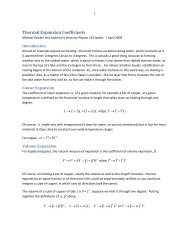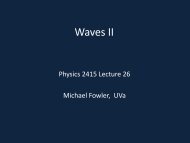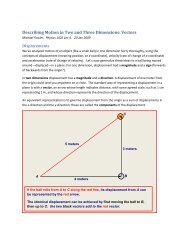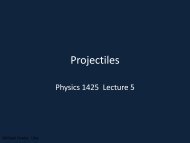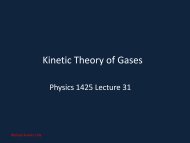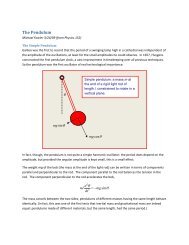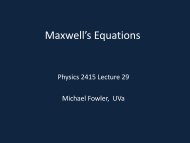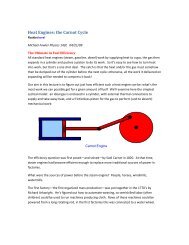Class Notes on Rotational Motion - Galileo and Einstein
Class Notes on Rotational Motion - Galileo and Einstein
Class Notes on Rotational Motion - Galileo and Einstein
Create successful ePaper yourself
Turn your PDF publications into a flip-book with our unique Google optimized e-Paper software.
3 t0 tt10 0 2 2 ( ).2 20 0Just be sure your system has c<strong>on</strong>stant angular accelerati<strong>on</strong> before using these formulas!2Torque: Seesaw PhysicsTorque is a measure of the effectiveness of a force in getting something rotating: actually we’ve comeacross this already in the discussi<strong>on</strong> of the seesaw. If a child sits at the end of a level empty seesaw, itbegins to rotate. O.K., it doesn’t get far, but there is angular accelerati<strong>on</strong>. And we know the if the childsits close to the pivot point, the seesaw turns more slowly.We’ve also seen that two children, <strong>on</strong>e twice as heavy sitting at half the distance, balance—we said theyhad the same leverage. This “leverage” is actually what’s called torque. It’s also called the “moment” ofa force about an axis of rotati<strong>on</strong>. It’s the product of the weight of the child <strong>and</strong> the distance from thepivot or axle.So, for a 20 kg child at a distance of 1.5m, the torque about the pivot point is 300 N.m, setting g = 10.d2d2mgmgBalancing a seesawWe can also have two forces <strong>on</strong> the same side of the pivot balancing—if <strong>on</strong>e of them is upwards. If a20kg child is sitting half way to the pivot, with no-<strong>on</strong>e <strong>on</strong> the other side, you could lift the seesaw to ahoriz<strong>on</strong>tal positi<strong>on</strong> by supplying an upward force equivalent to 10 kg weight at the end of the seesaw,the same side as the child.




